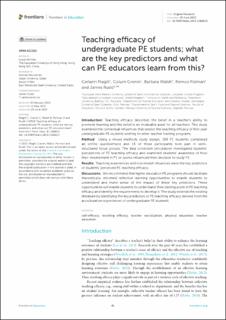| dc.contributor.author | Magill, Ceriann | |
| dc.contributor.author | Cronin, Colum | |
| dc.contributor.author | Walsh, Barbara | |
| dc.contributor.author | Polman, Remco | |
| dc.contributor.author | Rudd, James Robert | |
| dc.date.accessioned | 2023-10-24T08:11:26Z | |
| dc.date.available | 2023-10-24T08:11:26Z | |
| dc.date.created | 2023-09-05T15:14:06Z | |
| dc.date.issued | 2023 | |
| dc.identifier.citation | Frontiers in Education. 2023, 8, Artikkel 1166613. | en_US |
| dc.identifier.issn | 2504-284X | |
| dc.identifier.uri | https://hdl.handle.net/11250/3098248 | |
| dc.description | This is an open-access article distributed under the terms of the Creative Commons Attribution License (CC BY). The use, distribution or reproduction in other forums is permitted, provided the original author(s) and the copyright owner(s) are credited and that the original publication in this journal is cited, in accordance with accepted academic practice. No use, distribution or reproduction is permitted which does not comply with these terms. | en_US |
| dc.description.abstract | Introduction: Teaching efficacy describes the belief in a teacher's ability to promote learning and this belief is an invaluable asset for all teachers. This study examined the contextual influences that predict the teaching efficacy of first-year undergraduate PE students wishing to enter teacher training programs.
Method: Using a mixed methods study design, 168 PE students completed an online questionnaire and 16 of these participants took part in semi-structured focus groups. The data collection procedures investigated students' perceptions of PE teaching efficacy and examined students' awareness of how their involvement in PE or sports influenced their decision to study PE.
Results: Teaching experiences and role model influences were the key predictors of students' perceived PE teaching efficacy.
Discussions: We recommend that higher education PE programs should facilitate theoretically informed reflective learning opportunities to enable students to understand and make sense of the impact of these key predictors. These opportunities will enable students to understand their starting point in PE teaching efficacy and identify the requirements to develop it. The study extends the existing literature by identifying the key predictors of PE teaching efficacy derived from the acculturation experiences of undergraduate PE students. | en_US |
| dc.language.iso | eng | en_US |
| dc.subject | physical education | en_US |
| dc.subject | self-efficacy | en_US |
| dc.subject | teacher education | en_US |
| dc.subject | teacher socialization | en_US |
| dc.subject | teaching efficacy | en_US |
| dc.title | Teaching efficacy of undergraduate PE students; what are the key predictors and what can PE educators learn from this? | en_US |
| dc.type | Peer reviewed | en_US |
| dc.type | Journal article | en_US |
| dc.description.version | publishedVersion | en_US |
| dc.rights.holder | © 2023 Magill, Cronin, Walsh, Polman and Rudd | en_US |
| dc.source.pagenumber | 10 | en_US |
| dc.source.volume | 8 | en_US |
| dc.source.journal | Frontiers in Education | en_US |
| dc.identifier.doi | 10.3389/feduc.2023.1166613 | |
| dc.identifier.cristin | 2172661 | |
| dc.description.localcode | Institutt for lærerutdanning og friluftslivsstudier / Department of Teacher Education and Outdoor Studies | en_US |
| dc.source.articlenumber | 1166613 | en_US |
| cristin.ispublished | true | |
| cristin.fulltext | original | |
| cristin.qualitycode | 1 | |

